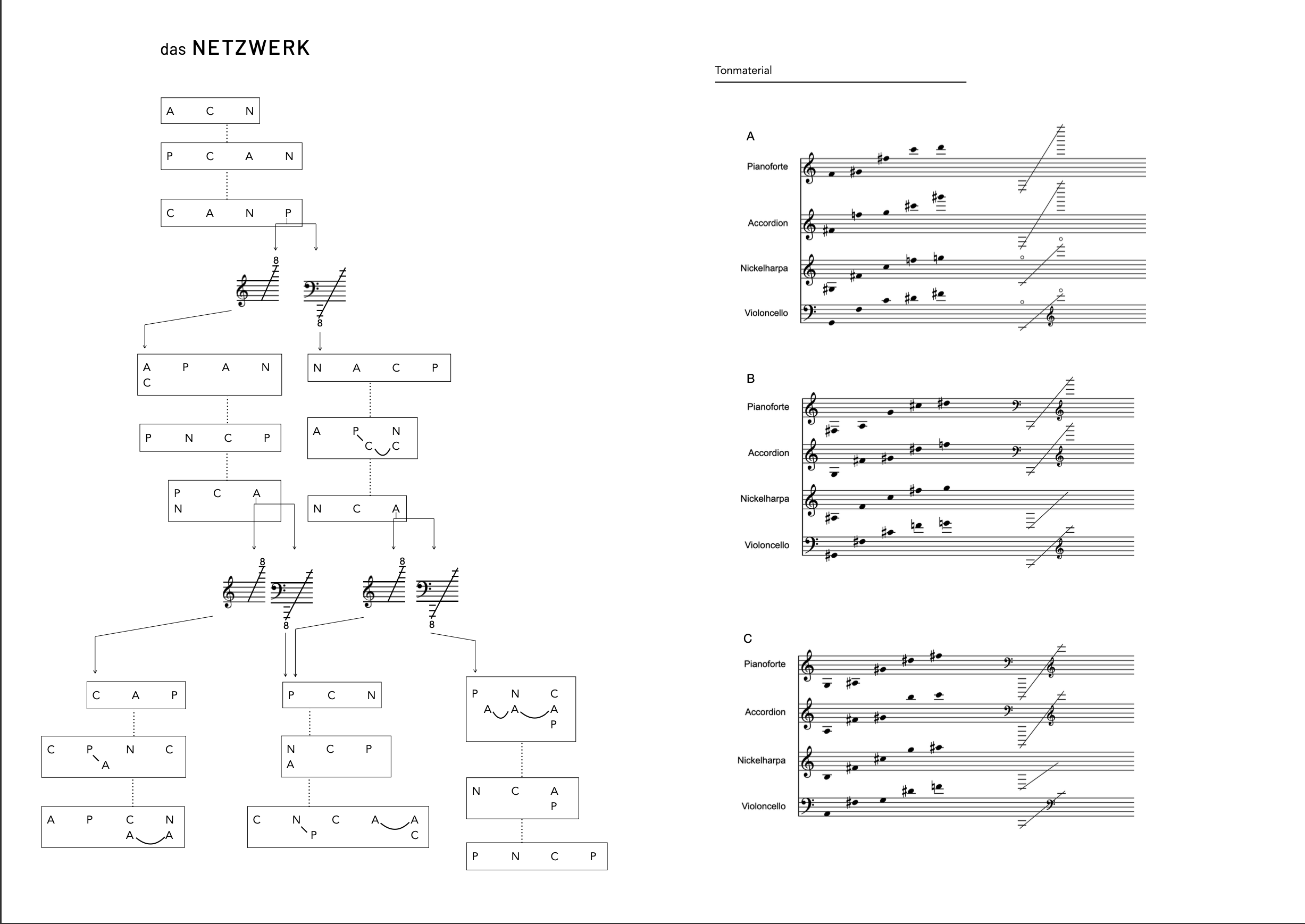CONCEPTS
-
Continuatio (and STATIO) explores the concept of time (mis)understanding in nature by experiencing an almost unchanging, continuous sound with occasional tonal fluctuations. This reflects the apparent stagnation and simultaneous subtle changes in natural processes over time.
-
"Continuum Circuli" reflects upon the cyclic patterns and evolution of nature. The composition embraces the concept that many phenomena exhibit repetitive cycles, yet constant change occurs within these cycles, shaping the ecosystem over time. Our anthropocentric notion of time often causes us to overlook these continuous transformations in nature.
NETZWERK ° 2023 ° IMPROVISATION WRITTEN FOR PENDULA ENSEMBLE
Inspired by the network of the tree’s roots.
Concept:
the melodic material consists of three sequences for each player; every sequence is repeated once throughout the “network”
range, duration and dynamics are only partly defined and mostly free for the player to choose (the melodic material is structured so that, similar to the growing of the tree’s roots, the melody is mostly played in the upper range to begin with and evolves in the lower range by the time the network has been played three times)
Add. note: the choreography is completely improvised, following just the mentioned above points and mostly inspired by the current sound
-
un-Formen explores the concept of time in nature, where what may appear to us as stillness is actually a slow progression of time. This feeling of motionlessness can be likened to the spaces between musical notes, where sound fades and one may not actively listen but rather seeks to avoid silence.
un_Form is an electronic-acoustic composition that builds upon a sequence of repeated and varied arpeggiated piano chords, representing the motion that occurs between the chords themselves. This continuous "Ausklang" is stretched and repeated in different variations to create an immersive sound that gradually moves through time.
PRE-RECORDED SOLO PIANO, VOICE + ELECTRONICS
-
The three movements explore possible forms of “Ausklang” (decay); this is emphasised by the musicians’ unusual seating order (Vc., Va., Vl.1, Vl.2, Db.).
All three movements are inspired from Caspar David Friedrich’s “The Monk by the Sea.”
Special note: the spoken parts are an English translation of a Japanese haiku into a new form using a system of phonemes inspired by Arabic, Chakobsa and Romani.
Original poem by Kobayashi Issa:
“In this world
we walk on the roof of hell
gazing at flowers.” -
Collaboration with dancers and choreographers Tommy Cattin and Simea Cavelti:
We intended to explore movements and sound based upon Chinese mathematician Yang Hui’s magic concentric circles, while also taking inspiration in the shapes drawn by star trails.
I wanted to create a sound that might represent elements in space: continuity, emptiness and growing sounds passing by.
Starting with a draft for fourteen voices for piano, I translated my work into electro-acoustic with the aim of distancing myself from the acoustics of the piano while still trying to keep the weight and gravity of the piece.
-
Conus Textile is named for a species of venomous sea snail. The material in the composition is based on a cellular automata that models the patterns in the snail’s shell, while pace and feel are inspired by the snail’s movements and environment. (Cellular automata)
Most of the electronic sounds are processed pre-recordings of the solo cello parts while a few others are selected samples giving the feeling of water-movement. It was important to articulate the illusion of a vast space that includes movements which might be encountered in deep water: still, slow, echoing, suddenly agitated. Cello and electronics are usually both concerned with motion of time and space. No cello sounds are electronically processed live.▲ About the Cone Snail and the State of its Oceans:
Cone snails are coming under intensive threat in the wild. Cone snails are intensively exploited for the ornamental trade and research.Their natural habitats, such as coral reefs and mangrove forests, are being degraded and destroyed by coastal development, fishery over-exploitation, pollution, disease epidemics, and global climate change. An estimated 26% of the planet’s coral reefs have already been seriously damaged or destroyed and 50% of the world’s mangroves cleared.
-
Nautilidae Sequenze is named after the last living genera of externally-shelled cephalopods, the Nautilus. For centuries, Nautilidae have been considered an example of sacred cosmic order in nature, as the proportions of their shells are similar to the Fibonacci sequence. Fibonacci’s sequence can be found throughout nature and is the core of the material in the composition. In addition to incorporating the geometry of the Nautilus shell within the piece, I aimed to create a feeling of continuity and of space without time; passages with rotational echoes and slow motion; aspects which might represent the movements of these absolutely stunning creatures in the vast silence of the deep ocean.
▲ about the Nautilus and the State of its Oceans:Nautiloids first appeared around 550 million years ago during the early Paleozoic era and the six species that remain of what was once a diverse lineage have changed little since this time. In the modern era, nautilus shells are widely collected by humans and commercial fishing for this animal is too common. Since 1987, export of chambered nautilus shells has been widely banned, but many countries continue to sell them. A small percentage are also taken for the aquarium trade. It has been reported that over the course of one two-year period, as many as 10,000 live animals were caught and killed for their shells. Given their slow growth, late maturity, low reproductive output, and limited mobility, chambered nautiluses are particularly vulnerable to overfishing
